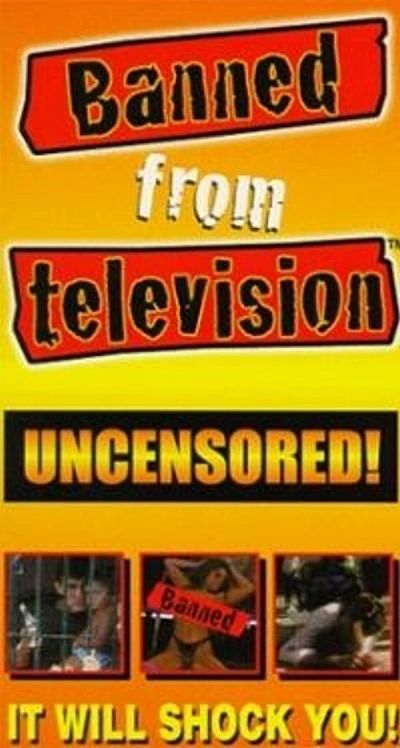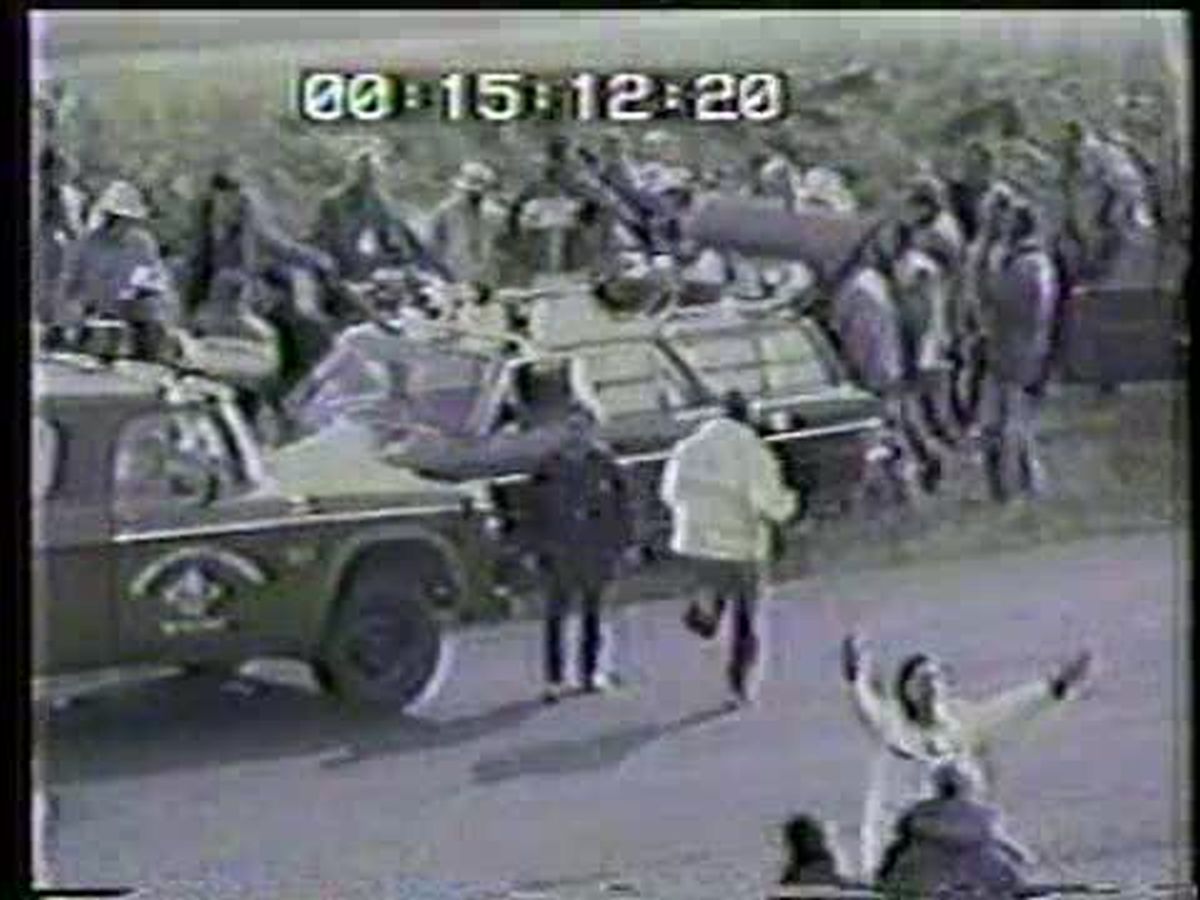“Banned From Television” = Banned From Video
In February, the BBFC announced, with much trumpeting, that ‘The Exorcist’ had finally been passed on video – a decision undeniably linked to the recent departure of chief censor James Ferman, who gave the film considerably more credit than it was worth. But the BBFC giveth, and the BBFC taketh away. At virtually the same time, and with a great deal less publicity, they refused two titles video certificates: Lucio Fulci’s ‘Cat in the Brain’ and the mondo documentary ‘Banned From Television’. The former was really no surprise – Fulci’s reputation alone meant that it was likely to get scrutiny, even though it’s nearer to the Peter Jackson school of excessive gore than anything which would threaten the fabric of society. [A bigger shock was that anyone actually wanted to release this tedious piece of dreck] The latter, however, perhaps deserves more investigation. First, here’s the press release sent out by the Board, explaining their decision:
“As the authority designated by Parliament with the responsibility for classifying videos under the Video Recordings Act 1984, the Board must determine whether or not a video is suitable for a classification certificate to be issued to it, with special regard to the likelihood of video works being viewed in the home. In making this decision, the Board must also have special regard, amongst other relevant factors, to any harm that may be caused to potential viewers or, through their behaviour, to society because of the manner in which the work deals with criminal behaviour, illegal drugs, violence, horror or sex.
The Board carefully considered this video in the light of these tests. The main consideration for the Board was the question of harm referred to above. In short, does the work have the potential for anti- social influence?
In the Board’s view it does. It is a compilation of scenes of extremely violent death, injury and mutilation, many of which are repeated in slow-motion. The commentary draws attention to the grislier aspects and in effect invites enjoyment at human suffering. The inclusion also of sex scenes reinforces the impression that the purpose of the video is to provide entertainment. There is no attempt to justify the images by placing the incidents in any other journalistic or educational context. Whatever current relevance the images might have had when they were originally photographed has been lost in the general compilation of horrors. The Board is conscious that a particular genre that has always been identified as entirely unacceptable is that of so-called ‘snuff movies’. Their main identifying feature is that at least one of the participants is actually killed. Banned From Television is only different in that, instead of a death being created for the work, actual death and injury is collated from a wide range of pre-existing sources to create the work.
The Board has concluded that the video is potentially harmful because of the influence it may have on the attitudes and behaviour of a significant proportion of likely viewers. The instinct of concern and compassion for the suffering of others is a basic social necessity. So is respect for the dignity of real human life. By presenting actual human death and mutilation as entertainment, the work, in the Board’s view, has the potential to erode these instincts. There is a danger of it falling into the hands of young and impressionable persons (whatever its classification) and of some significant brutalising effect on their attitude to human life and pain.
The Board has considered the possibility of cuts as a remedy for these difficulties. It has concluded, however, that they would be unlikely to modify the tone and effect of the work acceptably.”

Naturally, having read the above, it became my moral duty to see this film, and it proved no problem to pick up a copy on a recent trip to the States – alternatively, why not order over the Internet, at www.bannedfromtv.com? Three volumes available, all major credit cards accepted. [The irrelevance of the BBFC grows on a daily basis…]
My dislike of Mondo movies (and indeed, Mondo TV like “Police! Camera! Action!”) has previously been documented; partly because you need no real skill to put one together, and partly due to the pseudo-moralising that inevitably accompanies them. While Banned from Television is refreshingly free from such cant, it remains little more than a selection of “Bloody hell! Rewind that!” moments: a smorgasbord of crashes, police brutality, executions, animals on the rampage, criminal activity, etc. Interestingly, in some cases, sound effects have been added, so otherwise silent security video footage suddenly records gunshots. Mind you, far worse is the natural sound made when someone gets hit by a train [a clip which is on the TC website, and represents perhaps the epitome of the BH!RT! moment]. And the tape is censored, even if it says much about American attitudes that the only thing obscured, amid all the death and destruction, is a policeman’s dick.
But should it be banned? Of course not. This isn’t death video per se: while some clips are patently terminal, in others damage is slight – a source of wonder in itself – and a third group are left annoyingly unresolved. The main factor for inclusion isn’t the pain or injury, which are irrelevant – far more important is the BH!RT! quotient, though the supposedly “sexy” stuff – footage of lap dancers and the audience at a 2 Live Crew concert getting carried away – is largely tedious and tame.
I’ve watched enough fake mayhem to fuel a minor Balkan war, yet the real thing still appalls. The most horrific thing I ever saw was BBC News footage of Israeli soldiers deliberately and cold-bloodedly breaking Palestinians’ legs with boulders, and most of the clips here are similarly disturbing; man’s inhumanity to man is terrible to behold. Brazil is now crossed off my list of potential holiday destinations, having seen their police’s fondness for casual brutality and summary execution. Rodney King got off very lightly.
I doubt a normal citizen would feel any “brutalising effect”; if you aren’t shocked by parts of this tape, you’re clearly there already. It’s almost a relief to be upset by things like an El Salvador cop shooting a demonstrator in the chest at point-blank range – it just shows that cinematic violence only desensitises you to…cinematic violence. Mind you, my feelings for the victims did vary: I’ve little sympathy for anyone who takes part in bull-running, and the public execution of rapists is merely justice being seen to be done.
The video is valid, because this stuff happens, and people should be free to see it happening. I’d heard about the brutality of Brazilian police, but the reports of death squads no longer seem hyperbole – and nothing drives home road-safety better than seeing a car get absolutely totalled by a juggernaut. Rather than losing “respect for the dignity of real human life”, you come away with a new-found awareness of just how fragile and delicate it is; this ain’t the movies, where cars fly through the air and people crawl out slightly grazed. Here, you get shot, you fall down, you die. The BBFC’s claim that it’s “presenting actual human death and mutilation as entertainment” is wrong: it is eye-popping and jaw-dropping, but it’s also gut-wrenching and brutal, which is exactly how violence should be. The BBFC’s decision leaves the public with no perception of it beyond that of Hollywood, and in the long run, this may be potentially more damaging.
[2021 update. And, of course, you can now watch the whole thing on YouTube, BBFC be damned…]
